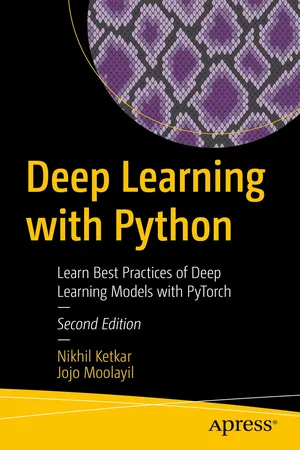
Deep Learning with Python
Learn Best Practices of Deep Learning Models with PyTorch
- English
- ePUB (mobile friendly)
- Only available on web
Deep Learning with Python
Learn Best Practices of Deep Learning Models with PyTorch
About This Book
Master the practical aspects of implementing deep learning solutions with PyTorch, using a hands-on approach to understanding both theory and practice. This updated editionwill prepare you for applying deep learning to real world problems with a sound theoretical foundation and practical know-how with PyTorch, a platform developed by Facebook's Artificial Intelligence Research Group.
You'll start with a perspective on how and why deep learning with PyTorch has emerged as an path-breaking framework with a set of tools and techniques to solve real-world problems. Next, the book will ground you with the mathematical fundamentals of linear algebra, vector calculus, probability and optimization. Having established this foundation, you'll move on to key components and functionality of PyTorch including layers, loss functions and optimization algorithms.
You'll also gain an understanding of Graphical Processing Unit (GPU) based computation, which is essential for training deep learning models. All the key architectures in deep learning are covered, including feedforward networks, convolution neural networks, recurrent neural networks, long short-term memory networks, autoencoders and generative adversarial networks. Backed by a number of tricks of the trade for training and optimizing deep learning models, this edition of Deep Learning with Python explains the best practices in taking these models to production with PyTorch.
What You'll Learn
- Review machine learning fundamentals such as overfitting, underfitting, and regularization.
- Understand deep learning fundamentals such as feed-forward networks, convolution neural networks, recurrent neural networks, automaticdifferentiation, and stochasticgradient descent.
- Apply in-depth linear algebra with PyTorch
- Explore PyTorch fundamentals andits building blocks
- Work with tuning and optimizing models
Who This Book Is For
Beginnerswith a working knowledge of Python who want to understand Deep Learning in a practical, hands-on manner.
Frequently asked questions
Information
Table of contents
- Cover
- Front Matter
- 1. Introduction to Machine Learning and Deep Learning
- 2. Introduction to PyTorch
- 3. Feed-Forward Neural Networks
- 4. Automatic Differentiation in Deep Learning
- 5. Training Deep Leaning Models
- 6. Convolutional Neural Networks
- 7. Recurrent Neural Networks
- 8. Recent Advances in Deep Learning
- Back Matter